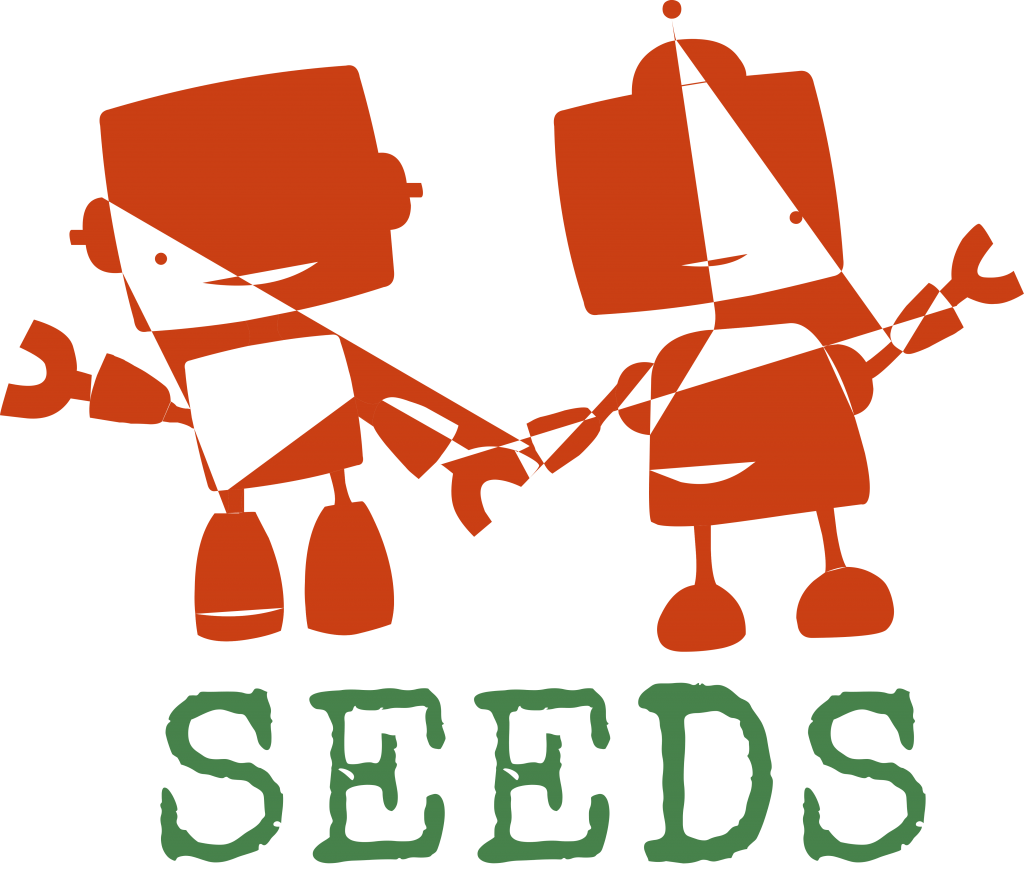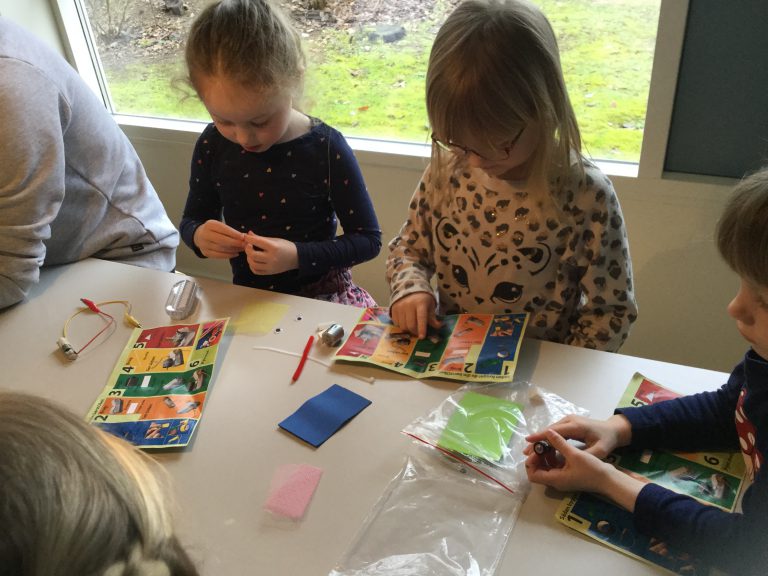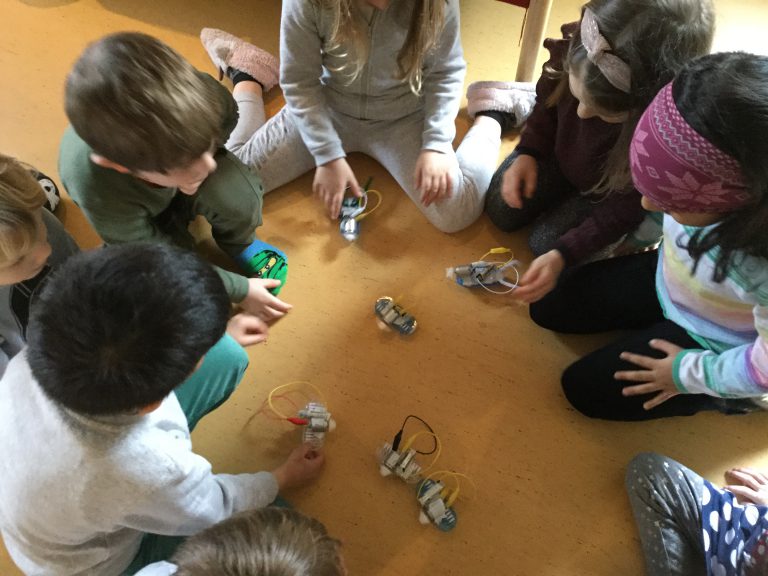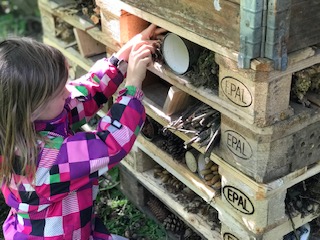


Recommendations
The SEEDS project has produced a publication that describes the framework for the SEEDS project – the 21st century skills, the national contexts for the preschools participating in the SEEDS project and the results of the project, as well as recommendations for implementing the SEEDS pedagogy, divided in 4 themes:
- Implementing the 21st century skills in preschools
- Preschool education in the light of the 21st century requirements
- Inclusive learning in preschools
- Developing technology for and with children
You can download the full report in English here.
Below you can find summaries of the recommendations in English, Danish, German, Italian and Greek:
1) MAKE COMPETENCES AND STRENGTHS OF THE INDIVIDUAL CHILD VISIBLE
It is important to challenge one’s own bias and assumptions, be it based on the perception of an individual child, an age group, gender or ethnicity. Often educators will make assumptions about what the child can do or might be able to do in order to prepare the learning activities. However, children are not all the same and might have very possibilities. When working with competence development, it is a good idea to set up learning environments and arenas where the child’s individual competences and strengths become visible for educators and children alike. Working with different roles for the children in cooperation and making their strengths and competences visible for themselves and each other can support their cooperation, relationships and self-confidence. It will give the child more self-confident to become aware of what it is good at, but also making other children aware of it can be beneficial, which can promote a better cooperation and social inclusion among the children. Moreover, it will support the educator working with the child perspective and supporting the learning path and development of the individual child.
2) LEARNING TO MAKE VALUE STARTING WITH THE INDIVIDUAL
When learning takes place, the individual is always at the center the learning. It is from the individual the motivation to learn comes and meaning making with respect to linking to what prior knowledge the individual has. The SEEDS project targets a social entrepreneurial mind-set, which is about making value for others. The change maker pedagogy, one of the methods of the SEEDS Pedagogy, was developed from research into entrepreneurship education, and describe different levels of activity that can support the development of an entrepreneurial mindset by finding solutions to problems in a dynamic between an individual and collective perspective.
The process starts with ME. Here you focus on the children, who they are and what is important to them. Then you move on to WE and bring the children together in a group. When groups work together, they are constantly articulating and reflecting on their own understanding in relation to the others in the group. It is here that community is established, that identity is constructed and challenged, sometimes even threatened. This is why there will always be space for movement between who I am, in relation to who I am as a member of the group. WE are not just about the group, but also about the whole preschool, the local community or other communities. Then the process moves on to DISCOVERY, which is characterized by asking, observing and trying out the limitations of different methods, materials and tools. In the discovery phase the group explores and investigates a problem or a situation focusing on:
- what resources and technologies are used,
- who are involved, their skills and expertise as well their relationships with each other,
- where the practice takes place, in a particular context and lastly,
- how the practice happens in the given situation.
Next comes EXPERIMENTATION, where the educator and children experiment with what could be done to the specific problem with a combination of different methods, materials and digital tools that has not been tried before. The final step is CONSOLIDATION, where there is room for testing and trial. The problem is solved when the group as a whole agrees on it. This is when value is created for the individual and for the community as a whole. This means being able to experiment, seek new and innovative ways to solve the problem and to test potential solutions together. The experimenting community moves back and forth in the change-maker model, creating value for themselves and others through all the phases.
3) NURSING CURIOSITY AS A DRIVER FOR PLAYFUL LEARNING
In order to foster entrepreneurial mind-set in young children, it is important to set up learning activities and environments that supports that. Such as starting with the Children’s own perception, curiosity and motivation to make the learning process active and meaningful. The pedagogical traditions that most preschools in Europe share is actually based on playful learning, exploring and following the curiosity and interest of the individual child. Some educators talk about following “the children’s track” when conducting preschool learning activities.
In the project, this was illustrated in activities where the children had more or less full influence on the content of the activities. Sometimes a child expressed a question or an interest in a topic and the educator took departure in this, in their activities, for example planning a whole activity around that topic. In other cases, the educator set a frame and let the children decide which direction to go and what to explore within that topic. Some educators expressed a need to change their role in the activity depending on what type of learning they wanted to facilitate. Sometimes, they would walk “in front of the children” to show things to them or tell them things they needed to know. Other times they would walk “beside the children” and engage in activities with the children, where they took on an active role and became curious and exploring together with the children, but not leading, but following and working together with the children. At other times the would walk “behind the children” and let go of control and let the children play and do as they wanted in the activities, and only give support when needed, to give place for free play.
4) GIVE THE CHILDREN COURAGE TO EXPLORE, TEST AND FAIL
In order to develop an entrepreneurial mind-set, it is essential to have the courage to put yourself in positions where you might fail. In order to be creative and innovative you have to be able to explore and test things out and this leads necessarily to potential mistakes. In fact, we learn more from our mistakes than our successes, because this leads to new discoveries and can inspire other solutions or possibilities that we did not see before. This however, requires an environment where it is accepted to fail and where it is just seen as part of the explorative process. So in order to inspire children to engage in explorative activities, it is important that the educators puts value on the process of exploring and testing, rather than looking for a right answer, and explore with the children what they learn, when things don’t go as planned or indeed fail. It can be beneficial for the educator to let go of the control of the activity and let the children explore on their own agency. They learn more from finding answers themselves than from being told the answer.
When trying out ideas, it’s important to create a space for open discussions. Try not to give the answers or solutions, but support the children in finding them by asking open questions. Follow up on questions with concrete try-outs and follow up on the try-outs with reflections and sharing of learning among the children. It can also be beneficial to work with collaborative learning among the children. They can share their perspectives and insights among each other, and help each other find solutions. Always make sure to create a safe environment where there are no wrong answers, but all answers should be encouraged as potential solutions and learning opportunities. When you ask children to reflect and share knowledge with each other you can support development of their communication skills, and teach them democratic skills like listening to each other’s perspective, accepting that there are more than one potential solution.
1) MAKING COMPETENCES MORE VISIBLE:
The process of reporting the activities in the activity reports has helped teachers to reflect on how they have integrated these competences into their activities. This process is making competences more visible, and therefore helping them integrating them in the school curricula.
Making competences more visible, also means that they are more easily measured and manage impact. As the skills become more visible, children are more equipped to solve problem creatively and cooperate, collaborate and communicate in creative ways. Children also feel empowered to act on their own, take responsibilities and actively participate in making decisions.
2) GIVING CHILDREN THE FREEDOM TO EXPRESS FREELY:
Observing children and their reactions during the experimentation process as well as how they interact with each is a great opportunity for them to explore their thinking process and reasoning, individual competences, communication skills, creativity and other. Learning how to direct a question without expecting a specific outcome is very important as it allows children to express freely. This process might uncover scenarios or aspect that were hidden or not so clear to the teacher and might encompass a series of competences and skills.
3) USING TECHNOLOGY TO CONNECT WITH OTHER SCHOOLS AND CHILDREN:
Based on the recommendations of the participating educators, children like to interact with other children online and particularly with schools from other countries. Online interactions could help children learn about other cultures, find alternative ways of communicating with children that do not speak the same language, learn more about the use of technology as a tool to connect with the world, etc. This could also have an impact on how accepting they become of different cultures, how they creatively solve challenges both with communication and with technology, how they collaborate and cooperate with other children to solve challenges and how they take initiative to solve these challenges. Connecting with other schools and cultures online and interacting with people from different backgrounds can help promoting social inclusion and diversity.
4) USING TECHNOLOGY AS A TOOL TO EXCHANGE IDEAS AND PRACTICES:
Children can use technology to connect with other schools at local and international level. Learning about other schools use of physical and digital resources is a fun way to explore, create activities and increase children’s curiosity to explore and experiment with different elements.
5) USING TECHNOLOGY TO LEARN MORE ABOUT RELEVANT TOPICS AND ORGANISATIONS:
Children could learn about other organizations by connecting with them online. Have digital tours to places they can’t visit physically, interact with experts that share information about interesting topics and use the opportunity to ask questions and learn more about the subject explored.
6) PROMOTION OF GROUP ACTIVITIES AND PEER-LEARNING:
The nature of group activities requires collaboration and cooperation. However, if not managed carefully, it could increase the risk of social exclusion. Educators should create environments that facilitates interactions and not limit the means of communication. The role of the group activities should allow children to participate in a group setting where they feel supported. They should have the means to help them express and communicate with each other. Children should be encouraged to participate, not just in terms of communicating with each other but by playing and experimenting with the resources or material available and ask questions within their groups.
7) IMPORTANCE OF REFLECTION:
Group activities should provide a space for reflection. This could be facilitated by asking children to respond to questions about the process within their groups or within a broader group of discussion. The reflection could be used in sub-sequent or follow-up activities. It could also be in a form of self-reflection during the implementation of the group activities.
8) PROMOTING EXPERIMENTATION:
As we have seen in the description of the experimenting communities, experimentation could happen either by having the teacher controlling the process which could have a guided outcome or by having the teacher participating in the process as a learner without expecting a specific outcome. Experimentation could be a tool to facilitate inclusion as it allows children to experiment in their own ways and learn more about the object. Experimentation is a form of participation.
9) PROMOTION OF CULTURAL DIVERSITY IN EDUCATION RESOURCES:
The development of resources that promote diversity and promote different cultures could help with the development of more inclusive societies. Children from diverse background will feel accepted and will be feel more confident to participate and engage in the different activities. A curricula that promotes diversity will also help children be more accepting of other cultures and develop empathy. Technology is great way to get children excited about learning about the other cultures and increasing the engagement of children in different activities.
1) PRESCHOOLS SHOULD WORK ON MAKING THE CHILD “SOCIALLY WELL-FUNCTIONING”:
Teaching children to socialize and build relationships is very important to promote, nourish and safeguard a social inclusive dialogue. It is preschools’ responsibility to improve the interpersonal skills of children, since parents do not prepare the children for this in the same manner as before.
2) PRESCHOOL, TRANSFORMED IN LEARNING COMMUNITIES, SHOULD USE TECHNOLOGY AS A MEANS TO ENCOURAGE AND FACILITATE SOCIAL INCLUSION:
SEEDS educators expressed how they have experienced new social inclusion potential and benefits of using technology. For example, the Danish preschool Paddehatten that has a child with ALS used a 360°-degree camera to give him inclusion in activities he could otherwise not participate in. Several Danish institutions, like Skibet, have talked about a method of educating super user children, which gives them a special social position, as well as highlights their competences.
Another aspect on which teacher must focus is to adopt a gender-free approach to technology. In fact, some preschools think that the gender difference in terms of technology is getting smaller, but there is still a gender difference in their approaches to technology and their interest in it. However, activities realized as part of the SEEDS project, proved that children, when left to explore alone technology and to be creative, tend not to form groups based on their gender.
3) SOCIETY SHOULD PROVIDE MENTAL HEALTH SUPPORT FOR INCLUSIVENESS OF ALL YOUNG PEOPLE:
We would recommend implementing mandatory weekly meetings for school students held by trained school specialist about mental hygiene. The workshops could include topics about stress, building self-confidence, time managing, being productive and focused, emotional intelligence etc. time managing, being productive and focused, emotional intelligence etc.
4) A SOCIALLY INCLUSIVE DIALOGUE MUST BE PROMOTED AT EUROPEAN AND LOCAL LEVEL:
We encourage the EU to coordinate and fund an agency providing a dialogue between diverse social groups on a local level promoting and improving European values throughout, providing a platform for all people to speak their mind and strengthen social cohesion.
1) INVOLVE FUTURE USERS IN DESIGN PROCESS AT DIFFERENT POINTS AND IN WORKING/LEARNING ENVIRONMENTS, WHICH SHOULD INCLUDE:
- To iterate again and again, e.g. by sharing progress online
- To give children and teachers what they want, e.g. by observing (and discussing) wishes and needs
- To support many styles, also by observing diverse wishes and needs / allow for many different ways to use it
- To invent things that you would also want to use yourself
- To draw on children’s and teacher’s ideas
2) DRAW ON ESTABLISHED PEDAGOGICAL PRINCIPLES AND ADD TECHNOLOGY WHICH INCLUDES:
- To design for designers / offer a starting point to work and to create with
- Easy ways to get started with the technology and diverse ways to use it (low floors and wide walls)
- Keep the technology simple and make ideas salient
3) Encourage sharing ideas and further development which (again) includes:
- To iterate again, e.g. by sharing new ideas online
- To invent things that you would also want to use yourself
- To involve more teachers or children or any future users and by that to create more diverse developments and reach more people in general


